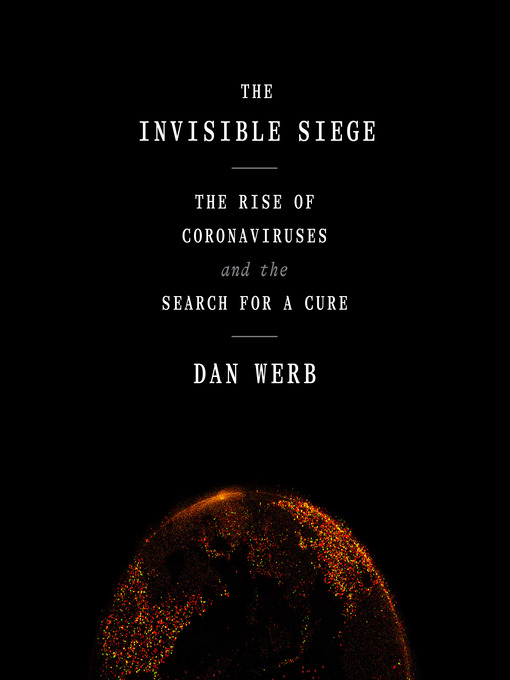The Invisible Siege
The Rise of Coronaviruses and the Search for a Cure
Winner of the Hilary Weston Writers’ Trust Prize • One of Publishers Weekly’s top ten science books of the season
The urgency of the devastating COVID-19 pandemic has fixed humanity’s gaze on the present crisis. But the story of this pandemic extends far further back than many realize. In this engrossing narrative, epidemiologist Dan Werb traces the rising threat of the coronavirus family and the attempts by a small group of scientists who worked for decades to stop a looming viral pandemic.
When virologist Ralph Baric began researching coronaviruses in the 1980s, the field was a scientific backwater—the few variants that infected humans caused little more than the common cold. But when a novel coronavirus sparked the 2003 SARS epidemic, and then the MERS epidemic a decade later, Baric and his allies realized that time was running out before a pandemic strain would make the inevitable jump from animals to human hosts.
In The Invisible Siege, Werb unpacks the dynamic history and microscopic complexity of an organism that has wreaked cycles of havoc upon the world for millennia. Elegantly tracing decades of scientific investigation, Werb’s book reveals how Baric’s team of scientists hatched an audacious plan not merely to battle COVID-19 but to end pandemics forever. Yet as they raced to find a cure, they ran into a complicated nexus of science, ethics, industry, and politics that threatened to derail their efforts just as COVID-19 loomed ever larger.
The Invisible Siege is an urgent and moving testament to the unprecedented scientific movement to stop COVID-19—and a powerful look at the infuriating factors that threaten to derail discovery and leave the world vulnerable to the inevitable coronaviruses to come.
-
Creators
-
Publisher
-
Release date
March 1, 2022 -
Formats
-
OverDrive Listen audiobook
- ISBN: 9780593506165
- File size: 393950 KB
- Duration: 13:40:43
-
-
Languages
- English
-
Reviews
-
Library Journal
September 1, 2022
Thanks to the ongoing COVID-19 pandemic, coronaviruses are part of our popular consciousness. But prior to 2020, they weren't a hot topic for scientific investigation. Epidemiologist Werb (City of Omens) shares the story of Ralph Baric, a virologist who began studying the coronavirus family in the 1980s, when the field was best described as a "scientific backwater." Baric's concerns about species-to-species transmission came to fruition during the SARS outbreak of 2003 and the MERS outbreak of 2012, and Werb chronicles the scramble to unlock the genomes of these deadly viruses in order to find a cure. This foundational understanding of the coronavirus genome gave researchers the ability to quickly respond to COVID-19. In addition, research on mRNA vaccines as a response to these earlier coronavirus outbreaks hastened the development of the COVID-19 vaccines. The sobering conclusion? It's a matter of when--not if--the next coronavirus makes the jump from animals to humans. Jason Culp's steady, measured narration helps listeners navigate the complex material, highlighting the tension, excitement, and drama of scientific discovery. VERDICT A well-presented book on an all-too-timely topic; suggest to readers who enjoy titles by David Quammen.--Nanette Donohue
Copyright 2022 Library Journal, LLC Used with permission.
-
Publisher's Weekly
Starred review from January 3, 2022
Epidemiologist Werb (City of Omens) takes a page-turning and unsettling look at the history of coronaviruses. Working to “put boundaries on our anxiety” by placing Covid-19 in its scientific and historical context, he writes that coronaviruses are nothing new, but before 2003, were only known to cause mild colds. That changed with that year’s SARS epidemic, which claimed hundreds of lives. Werb covers the scientists who studied coronaviruses in obscurity with minimal funding—Ralph Baric, for example, devoted himself to analyzing the potential adaptability of coronaviruses in the 1980s and found that they could evolve to thrive in a new species very rapidly. The implications of that finding, Werb notes, are reflected in the current state of affairs, when the ever-increasing “encroachment of humans into the habitats of animals that harbor coronaviruses” explains why “the first two decades of the twenty-first century have seen more novel human pathogens emerge than across the entire twentieth century.” Werb describes doctors working toward an outlook that views animal, human, and environmental health as interconnected, and the light he sheds on scientists whose work has gone largely under the radar makes for a moving account. This is a unique and valuable addition to the expanding body of work on Covid-19.
-
Loading
Why is availability limited?
×Availability can change throughout the month based on the library's budget. You can still place a hold on the title, and your hold will be automatically filled as soon as the title is available again.
The Kindle Book format for this title is not supported on:
×Read-along ebook
×The OverDrive Read format of this ebook has professional narration that plays while you read in your browser. Learn more here.


